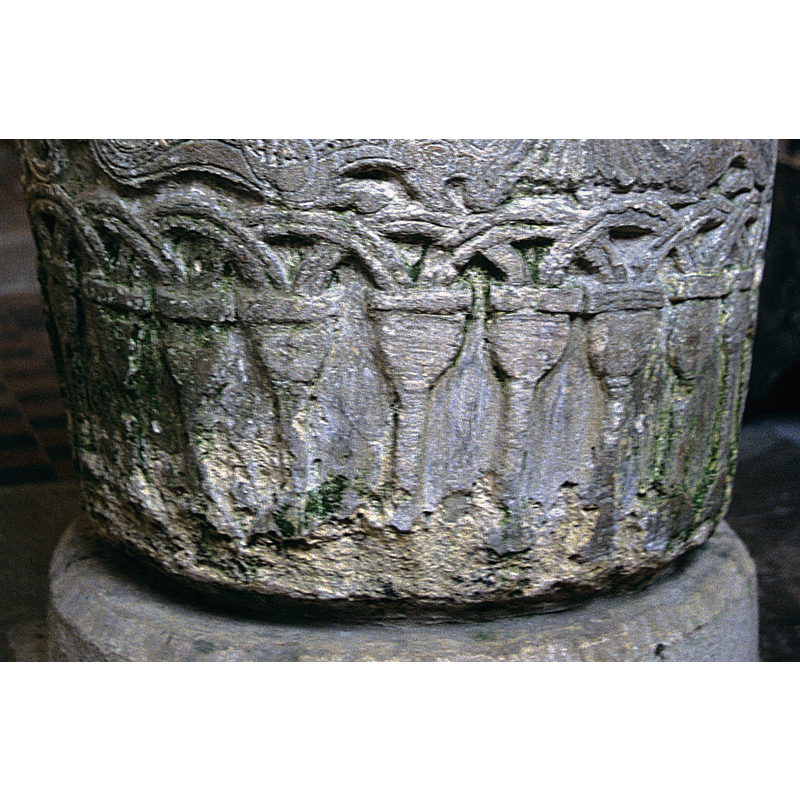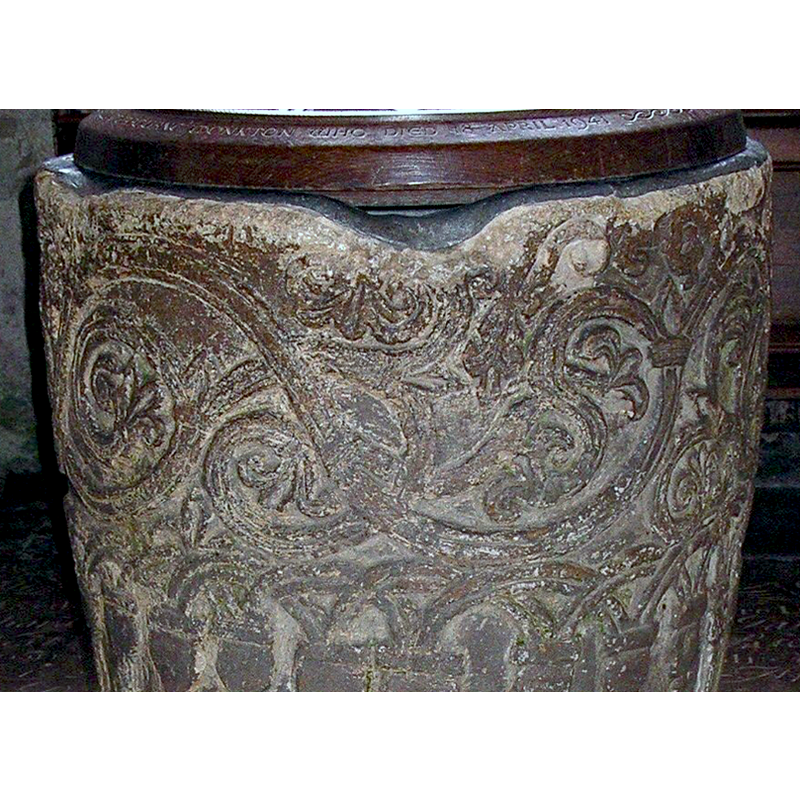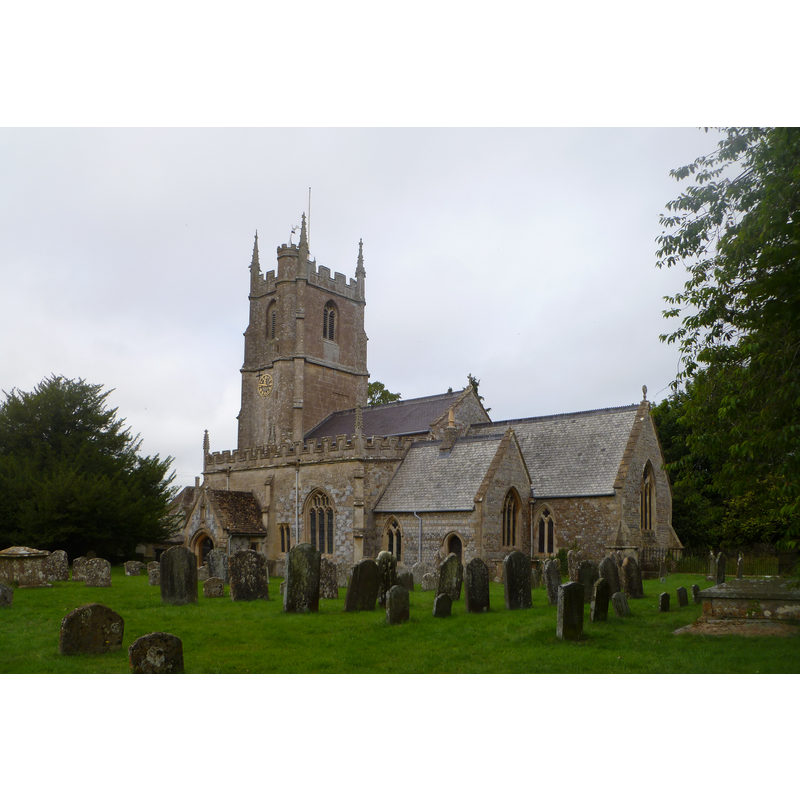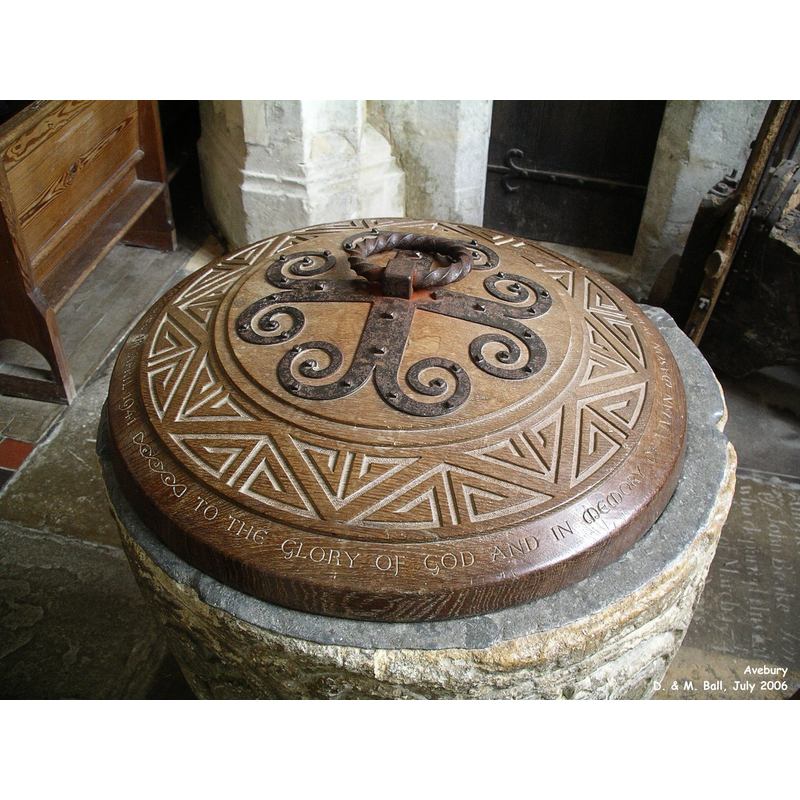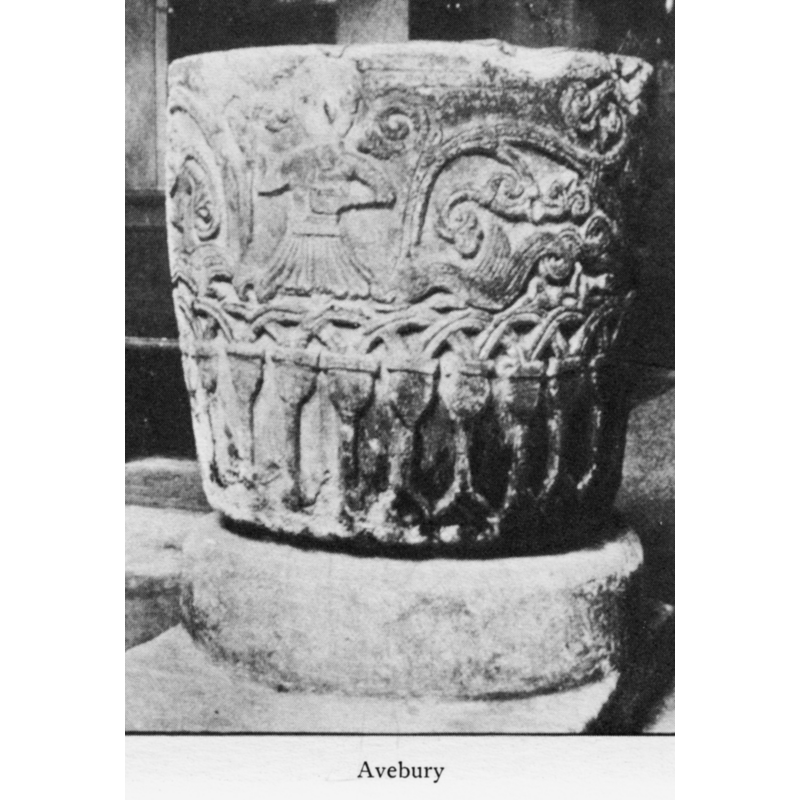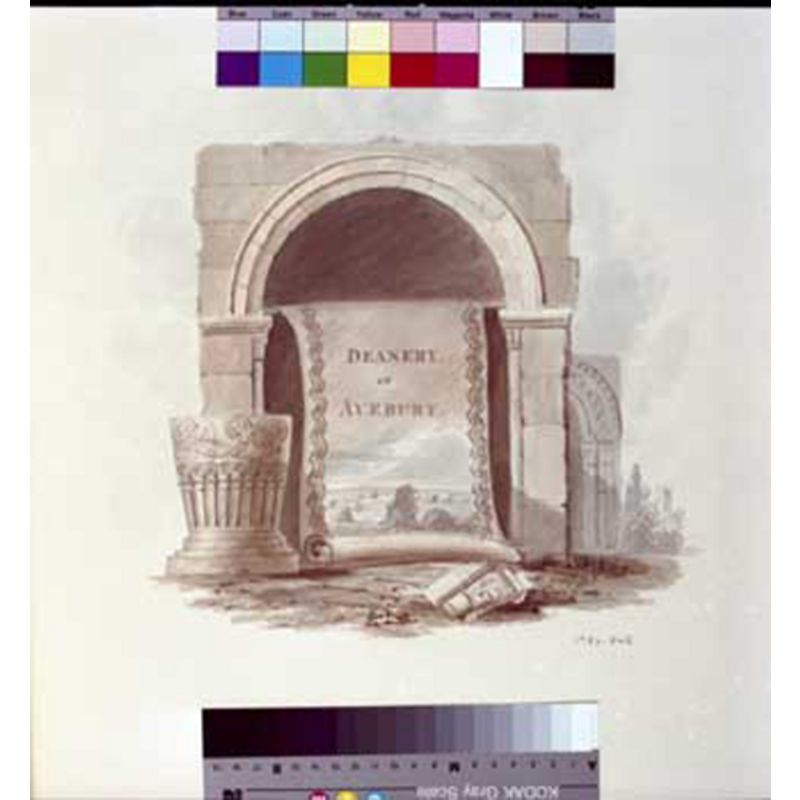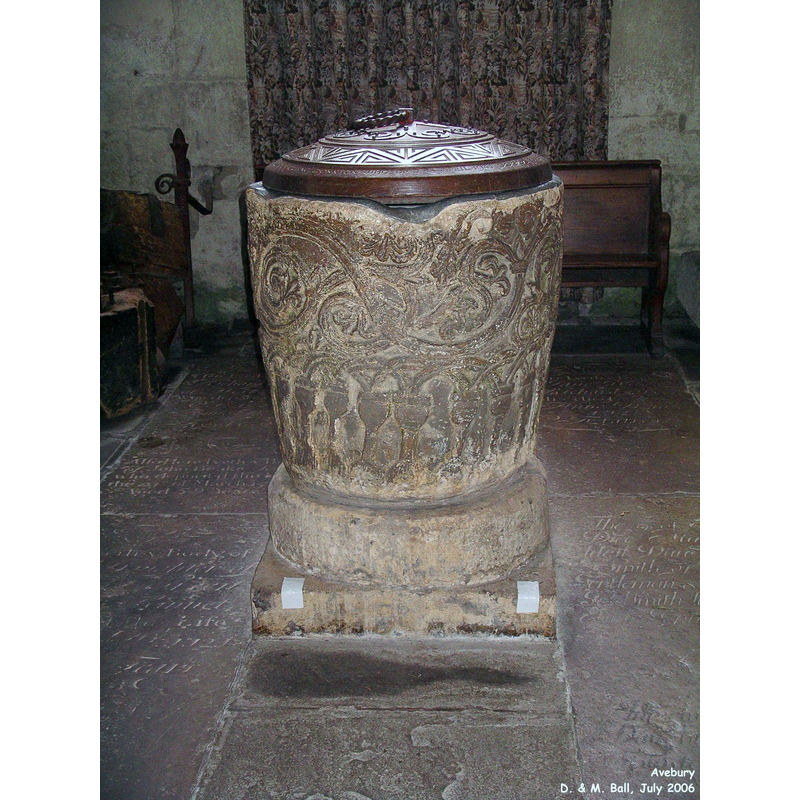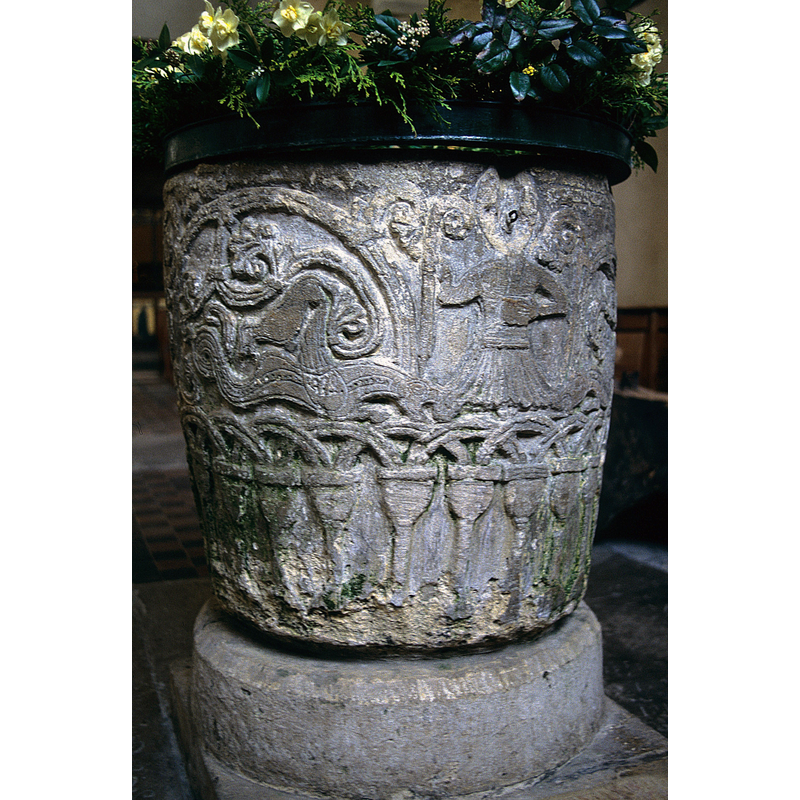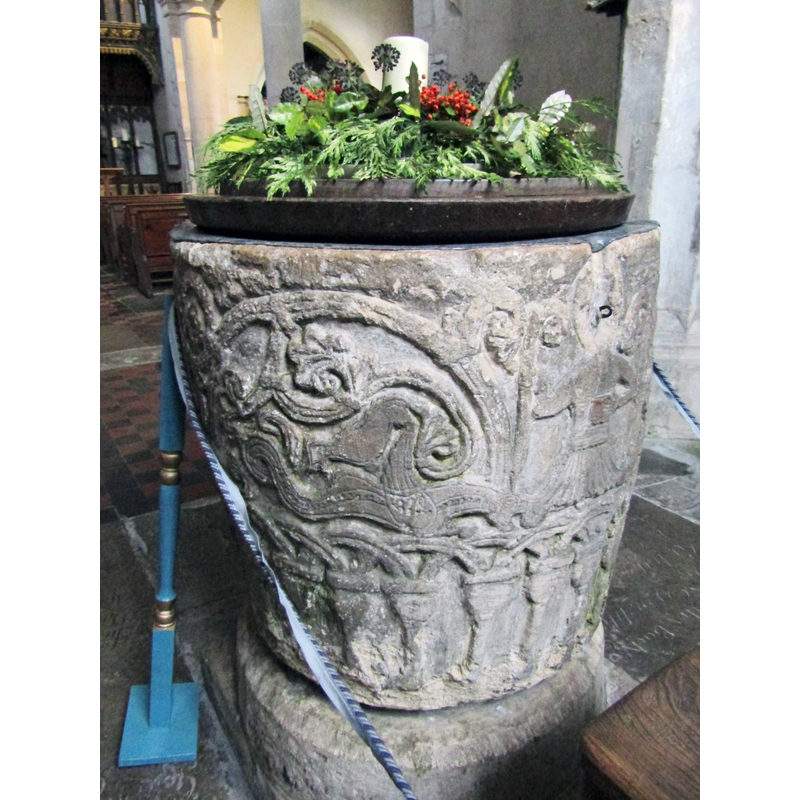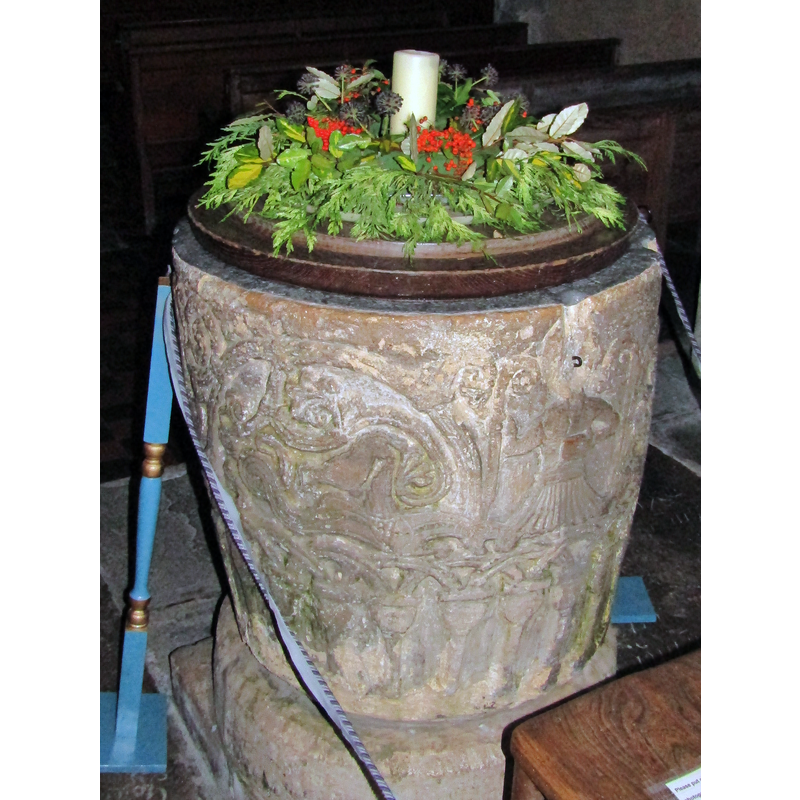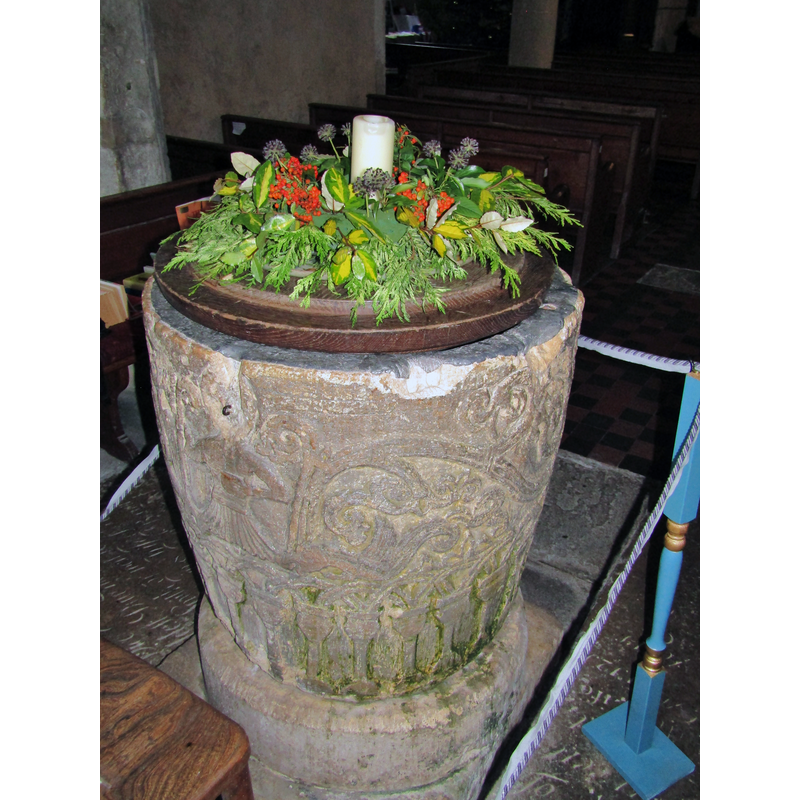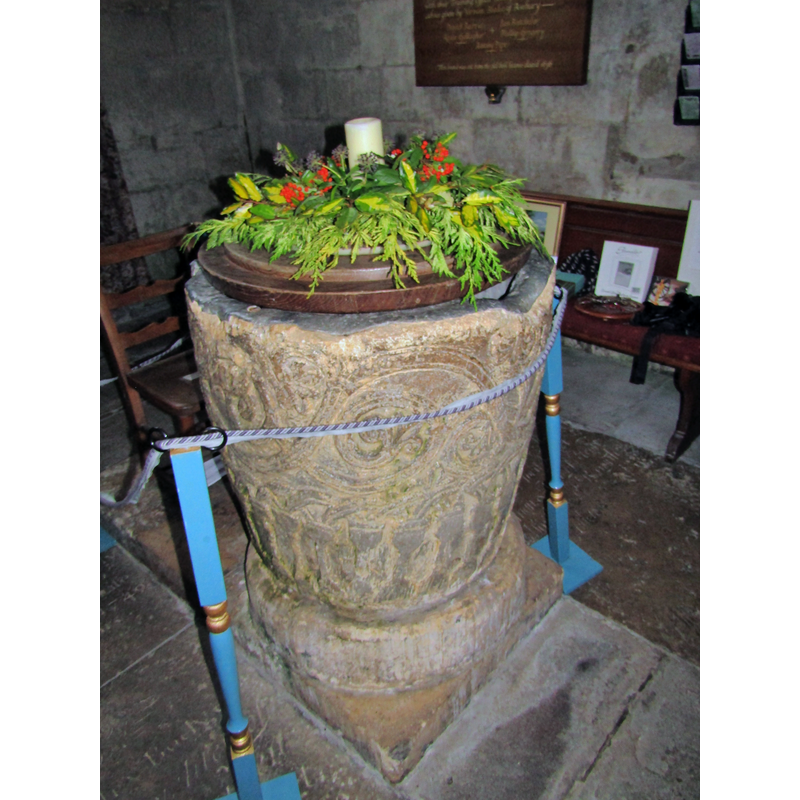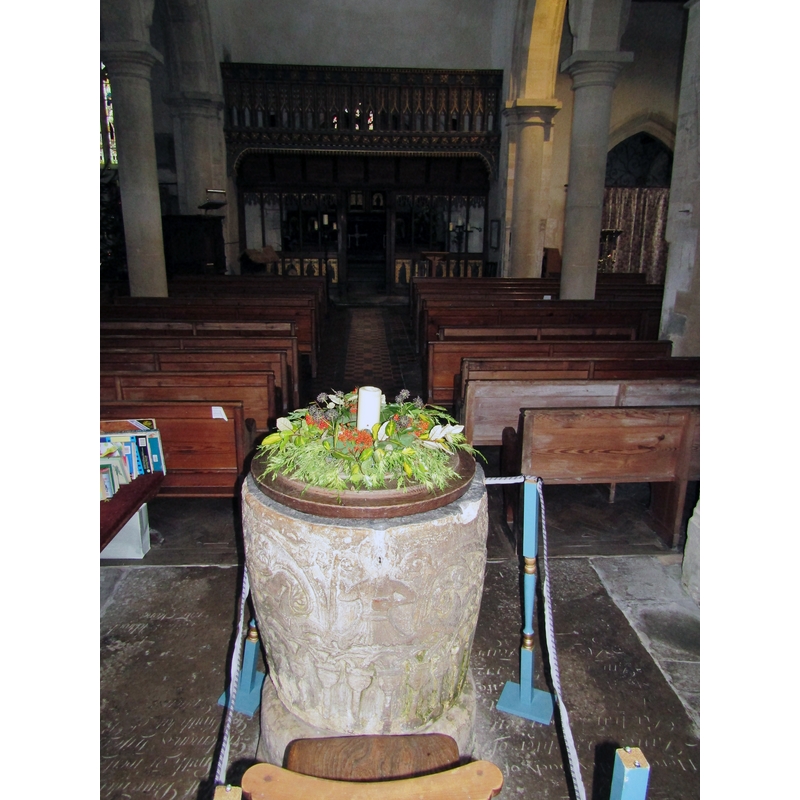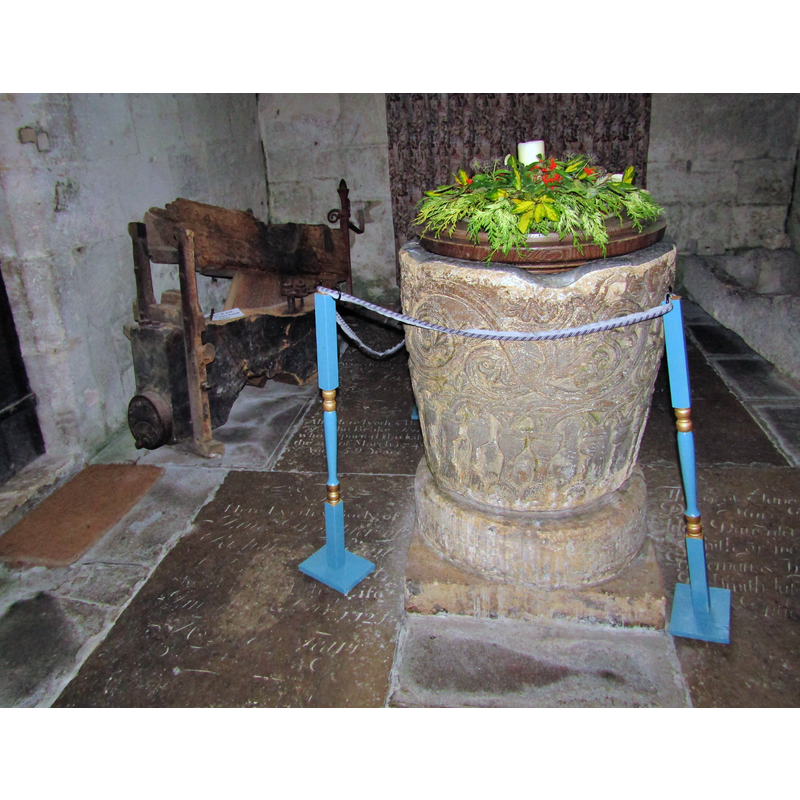Avebury / Aureberie / Avreberie
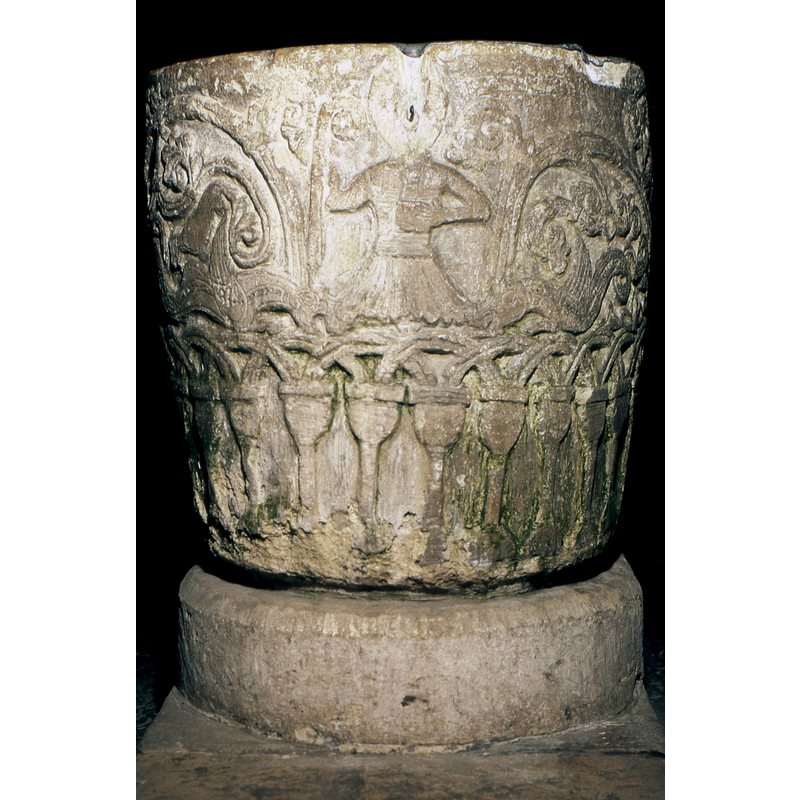
Image copyright © Baptisteria Sacra Index, 2023
Results: 22 records
angel - archangel - St. Michael and dragon?
Scene Description: There is only one scene on the font, on the western side [on the east side in Paley (1844)], which shows a figure holding a bishop's staff (Christ or St. Michael or Bishop?) (the head is defaced) piercing the head of a serpent with the bishop's staff. A second serpent is carved on the right side of the figure. This is carved in the upper register along with an ornate acanthus motif encircling the remainder of the bowl. The lower register of the bowl has an acade, with its arches over-lapping around the bowl.
Copyright Statement: Image copyright © Adrian Fletcher, 2010
Image Source: digital photograph taken 9 November [?] buy Adrian Fletcher [www.paradoxplace.com]
Copyright Instructions: Standing permission
animal - fabulous animal or monster - dragon
design element - architectural - arcade - blind - round arches - double arches - intersecting arches - columns with capitals and bases
Scene Description: small round arches on tall heavy columns -- notice the deterioration of the stone in some areas
Copyright Statement: Image copyright © Timothy Marlow, 2015
Image Source: detail of a photograph taken 15 April 1993 by Timothy Marlow
Copyright Instructions: Image and permission received (letter of 26 October 2013)
design element - motifs - foliage
view of basin - detail
view of church exterior - southeast view
view of cover
view of font
view of font
view of font
Copyright Statement: Image copyright © Wiltshire County Council Libraries & Heritage, 2008
Image Source: digital image of a ca. 1810 watercolour by John Buckler, in the Wiltshire Heritage [http://www.wiltshireheritagecollections.org.uk/index.asp?page=item&mwsquery=({Category}={art})&itemSearchStart=1&id=12823] [accessed 23 December 2008]
Copyright Instructions: Standing permission
view of font
view of font and cover
view of font and cover
view of font and cover
view of font and cover
view of font and cover
view of font and cover
view of font and cover
view of font and cover in context
view of font and cover in context
INFORMATION
FontID: 00163AVE
Object Type: Baptismal Font1
Church/Chapel: Parish Church of St. James
Church Patron Saints: St. James [formerly dedicated to All Saints]
Church Location: Church Walk, Avebury SN8 1RG, UK
Country Name: England
Location: Wiltshire, South West
Directions to Site: Located off the A361, 9 km W of Marlborough
Ecclesiastic Region: Diocesis of Salisbury
Historical Region: Hundred of Selkley [in Domesday]
Font Location in Church: Inside the church, at the W end of the nave, E of the S entranceway
Century and Period: 11th - 12th century [altered font?], Pre-Conquest [altered?] / Norman?
Credit and Acknowledgements: We are grateful to the Wiltshire County Council Libraries & Heritage for the permission to reproduce Buckler's image. We are also grateful to Duncan & Mandy Ball, of www.oodwooc.co.uk, to Adrian Fletcher, of www.paradoxplace.com, to John Wilkes, to Timothy Marlow and Colin Smith for their photographs of this church and font
Font Notes:
Click to view
There is an entry for Avebury [variant spelling] in the Domesday survey [http://domesdaymap.co.uk/place/SU1069/avebury/] [accessed 28 February 2015]; it mentions a church and church lands in it. A font here is illustrated in a ca. 1810 watercolour by John Buckler [Wiltshire Heritage Library, accession no. DZSWS:1982.545]. Noted and illustrated in Britton's Dictionary of 1838 and in Paley (1844). The Wiltshire Archaeological and Natural History Magazine (vol. XIX (1881): 22) reports on an excursion to Broad Hinton [inter alia] by the members of the Society in which they visit the church and note "the rudely-carved, but most remarkable Norman font". Cox (1875) and Andre (1882) include this font [by mistake] in a list of the "leaden fonts of England". Lethaby (1893) writes: "The font at Avebury, Wiltshire, has often erroneously been stated to be of lead; there is a resemblance in the design, but it is of stone painted." Listed in Cox & Harvey (1907) as a noteworthy baptismal font of the Norman period. Bond (1908) suggests that, although the sculpture on this baptismal font is "barbarous", the capitals are "of the cushion type of the twelve century" and places it with the Norman fonts. Holmes (1922) notes: "The font may be Saxon, though the ornamentation is of a later date". Tyrrell-Green (1928) writes: "the triumph of grace through the ministry of the Church is set forth by the figure of a bishop slaying the Serpent". Buck (1950) suggests it was originally a plain tub font "originally made in Saxon times, possibly during the Second Saxon Period, c. 880-980. It was then probably without any carving [...] and when in the twelfth century the Normans added aisles to the original Saxon nave and carved the south doorway they also carved what is now seen on the sides of the font", the latter addition done ca. 1125-1150, according to Buck (ibid.) Hutton (1957) suggests that this baptismal font may be Saxon "because of its un/Norman shape", although farther down he offers that it could be "early Norman, executed by a Saxon craftsman to a Norman's instructions." Noted in Pevsner & Cherry (1975), who remark on the "figure of a saintly bishop holding a crozier. His pleated cassock is a typically Norman feature." The Victoria County History (Wiltshire, vol. 12, 1983) notes: "The church held by Rainbold the priest in 1086 was probably newly built. [...] In 1139 it passed to Cirencester abbey, which held the church and advowson until the Dissolution. [...] church, known as All Saints' in the 13th century [...] but later as St. James's [...] The nave is of the 11th century [...] There is a tub font, possibly of Saxon origin, with carvings of the early 12th century." Pollard & Reynolds (2002) argue that "towards the end of the twelfth century, the church acquired its finely decorated font, which is almost certainly not Anglo-Saxon as it is often claimed [...], although certain stylistic details of the upper band of decoration do suggest Anglo-Scandinavian influence/survival/revival[...]. The form of the beasts, especially the heads, eyes and body, is reminiscent of pre-Conquest styles, as are the tails of the beasts as they wind their way down the body of the font into a floral scroll." By contrast, however, argue Pollard & Reynbolds (ibid.), the lower panel decoration is "all solid late twelfth-century work. The move to gothic style can be seen in the way in which the overlaid Romanesque blind arcades produce sharply pointed arches as a by-product." Pollard & Reynolds (ibid.) furtther argue that "there are strong archeological indications, however, that the decoration of the font is of two separate periods." On-site notes: the font is quasi-cylindrical and mounted; the inner basin well is lined with lead and has a wooden lid on top dated to 1940s in memory of Vicar Pooley. There is only one scene on the font, on the western side [NB: it was reported by Paley (1844) on the east side, but Buck (1950) suggests the font was moved in the 19th-century renovation] which shows a figure holding a bishop's staff (Christ or St. Michael or Bishop?) (the head is defaced) piercing the head of a serpent with the bishop's staff. A second serpent is carved on the right side of the figure. This is carved in the upper register along with an ornate acanthus motif encircling the remainder of the bowl on the upper register. The lower register of the bowl has a blind arcade of intersecting arches around the bowl. The bowl is separate from the base. The plinth is rectangular and projects with a priest's step. The drainage hole in the bowl is off-centre and there is evidence of a previous lid, with staples inserted into the upper rim. Both basin and base are round.
COORDINATES
Church Latitude & Longitude Decimal: 51.42856, -1.858128
Church Latitude & Longitude DMS: 51° 25′ 42.82″ N, 1° 51′ 29.26″ W
UTM: 30U 579383 5698103
MEDIUM AND MEASUREMENTS
Material: stone, type unknown
Number of Pieces: two
Font Shape: tub-shaped
Basin Interior Shape: round
Basin Exterior Shape: round
Drainage Notes: lead lining
Rim Thickness: 6-9 cm*
Diameter (inside rim): 61-62 cm*
Diameter (includes rim): 65-67 cm* / 75 cm**
Basin Depth: 40 cm* / 42.5 cm**
Height of Basin Side: 71 cm* / 70 cm**
Basin Total Height: 71 cm*
Height of Base: 18 cm*
Font Height (less Plinth): 89 cm*
Font Height (with Plinth): 102 cm*
Notes on Measurements: * BSI on-ste / ** in ft/in in Buck (1950)
LID INFORMATION
Date: 1941
Material: wood
Apparatus: no
Notes: the inscription on the sides acknowledges the dedication to Vivian Mason Pooley, Vicar of Avebury, who died 18 April 1941
REFERENCES
Victoria County History [online], University of London, 1993-. Accessed: 2012-02-06 00:00:00. URL: https://www.british-history.ac.uk.
André, J. Lewis, "Leaden Fonts in Sussex", 32, Surrey Archaeological Collections, relating to the history and antiquities of the county, 1882
Bond, Francis, Fonts and Font Covers, London: Waterstone, 1985 c1908
Britton, John, A Dictionary of the Architecture and Archaeology of the Middle Ages, including […], London: Longman, Orne, Brown, Green, and Longmann, Paternoster Row, and the Author, Burton Street, 1838
Buck, A.G. Randle, "Some Wiltshire fonts. Part I", LIII, CXCIII (December 1950), The Wiltshire Archaeological and Natural History Magazine, 1950, pp. 458-470; p. 463, 464
Buck, A.G. Randle, "Some Wiltshire fonts. Part II", LIV, CXCIV (June 1951), The Wiltshire Archaeological and Natural History Magazine, 1951, pp. 19-35; p. 25
Cox, John Charles, 1875-1877
Cox, John Charles, English Church Furniture, New York: E.P. Dutton & Co., 1907
Cox, John Charles, Nottinghamshire, London: Allen, 1912
Holmes, Edric, Wanderings in Wessex: an Exploration of the Southern Realm from Itchen to Otter, London: Robert Scott Roxburghe House, [1922]
Hutton, Graham, English Parish Churches, London: Thames & Hudson, 1976
Jenkins, Simon, England's Thousand Best Churches, London and New York: Allen Lane, the Penguin Press, 1999 [2000 rev. printing]
Paley, Frederick Apthorp, Illustrations of Baptismal Fonts, London, UK: John van Voorst, 1844
Pollard, Joshua, Avebury: the Biography of a Landscape, Stroud, Gloucestershire: Tempus Publishing, 2002
Tyrrell-Green, E., Baptismal Fonts Classified and Illustrated, London: Society for Promoting Christian Knowledge: The Macmillan Co., 1928
![There is only one scene on the font, on the western side [on the east side in Paley (1844)], which shows a figure holding a bishop's staff (Christ or St. Michael or Bishop?) (the head is defaced) piercing the head of a serpent with the bishop's staff. A second serpent is carved on the right side of the figure. This is carved in the upper register along with an ornate acanthus motif encircling the remainder of the bowl. The lower register of the bowl has an acade, with its arches over-lapping around the bowl.](/static-50478a99ec6f36a15d6234548c59f63da52304e5/compressed/1100718026_compressed.png)

